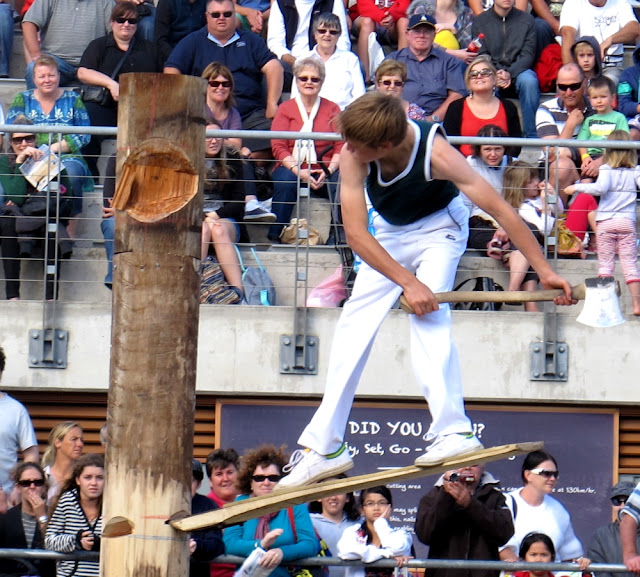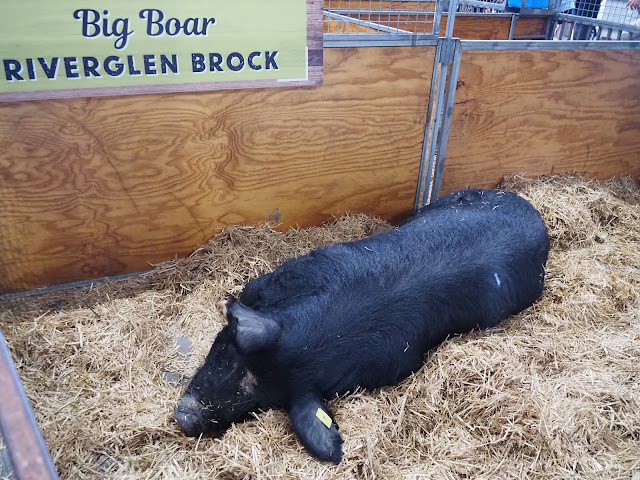This is here mainly for the pics, but I wrote most of the text when the internet was young, so I will use it. Some pics from 2025, some from 2012.
Every town and city of any pretension has its show, but I need to distinguish ‘the show’, which is the Royal Agricultural Society's ‘Easter Show’ from other smaller imitations around the state. I will say more about the ten-day Easter Show later: first, let's look more closely at the rural show, for most country towns of any size will have one, and these were the fore-runners of the ‘Show’ that everybody knows and loves today. The crowds prove it.
There is an established circuit for the country shows, and
the show folk follow the same route each year, with hoop-las, shooting
galleries (if there are prizes to be won, the sights on the rifles will be
bent), darts games, mirror maze, hot dog vans, fairy floss (pink spun sugar)
machines, and all manner of ‘try your luck’ routines. And since they only come
once a year, there is always a market for their offerings.
Then there are the prizes for cut flowers, where the local Dahlia specialist can display all of his
(or her) prize blooms, or those that have survived the opposition's sneaking
around at night to lob buckets of snails into the specialist's garden.
This is a serious business to the locals, and whole families seek to dominate certain sections in the arts and crafts pavilion. Outside, others are equally competitive in the pet shows and pony shows, or in the displays of livestock, but in the main ring, something different is going on. Here are three shots of the daily Grand Parade, taken in 2012,
There are organised groups who follow the shows, just to take part in the equestrian events. For weeks, months even, they follow the circuit, riding their horses in every possible event, and competing with the few local hopefuls who mostly enter only at the lower grades. There are also places where city folk can Meet the Animals Depending on the showground, which usually surrounds the local football field, there may also be trotting races, where a horse tows a skeletal gig (hardly more than two light shafts, a seat and two bicycle wheels) around a track. In a few towns, they may even organise the local picnic races to coincide with the show.
The most spectacular event at the show is always the woodchop
events. The men who enter these ‘races’ have spent their lives working on
hardwood, and they have axes which are razor sharp. The logs they have to chop
are usually about a foot (30 cm) through, and they are all seasoned gum.
One type of event involves standing on a length of log,
mounted on a metal stand, and chopping through the log, chopping out two V
shapes between the axeman's feet. This simulates the work of cutting a fallen
tree into haulable lengths, but the more exciting event simulates actually
felling a tree.
Gum trees usually have a broad buttress at the base, so
timber-getters always cut through a tree several metres above ground level. To
get there, they cut into the tree at about shoulder height, insert a plank,
swing up onto it, cut a second plank-hole, insert a second plank, clamber up
onto that, and so on. In the show event, the logs are set vertically in the
ground, and the wood choppers have to lop off the top section of the log, after
they have climbed up to it.
To make life more interesting, the events are run on a
handicap basis, with the ‘gun’ axeman left stranded on the ground, sometimes
until the first starter is up in the air, and almost halfway through his log,
almost ready to clamber down and re-set the planks to complete the cut from the
other side. This means that the finish is usually very close: it is also
spectacular.
Even in ‘the bush’, the life style that is represented in the
shows is one that has passed us by. Timber getters do not chop trees with axes
when they can use chain saws and bulldozers to bring the trees down faster, and
these days, there are even special chain saw races, cutting three discs from a
six-inch length of 18 inch haedwood log. Horses are only kept so people can
learn to perform on them — only the working dogs are as they always were, and I
will say more about them some other time.
But however rural life has changed, we conveniently ignore
all that at show time, especially at the serious show time when the bush comes
to the city for the Royal Easter Show, and the city visits the bush for a day
or so. There are more important things to worry about.
For a parent, survival is what counts at the Easter Show. In
the weeks leading up to the Show, men will discuss it over a beer in the pub,
offering each other handy hints. ‘Take an extra handkerchief’, growls an old
veteran. His younger companion asks if this is to keep off the dust.
The old man is patient. ‘No, to put through the handles of
yer show bags. The kids want 'em, but they won't carry 'em, and the handles cut
yer hand somethin' awful.’ After this long speech, he draws again on his glass.
He has done his share, paid his dues, and if he goes to the show now, it will
be on one of the quieter days when the crowds are smaller, and the children
fewer.
The young, of course, can survive almost anything. It is the
parents who are under the greatest strain. First, getting their young ready,
into public transport (those who drive to the Show are fools or masochists),
then keeping their young together, raising the cash for fast food, carnival
rides, sideshows, sample bags and more, finding the lost young, sitting calmly
in the police tent, eating ice cream and chatting to the duty police, all of
these take their toll.
This, of course, is the time, when the parents will power is
under stress, that the young decide they would like a further nasal assault, and
demand to be taken to see the animals. Determinedly, they haul their elders
past cattle, pigs, poultry, goats and sheep of many kinds, alpacas, deer, more
cattle, through to the areas where small cage birds, cats and dogs are
displayed.
This is what the show is all about, for a highly-rated animal
at the Royal will command greater fees for its stud performances or litters. Over
in another stall, beef cattle are examined before being slaughtered so the beef
can be internally inspected. Over Show Week, prestigious butchers will display
the ribbons won by dead cattle in their windows, telling all and sundry that
they have paid over the usual rate to buy highly-regarded meat.
The regions of the state compete against each other with
displays of produce, artistically arranged to paint a picture of their region,
and the city folk will wander past, giving this scant regard. On the last night
of the show, canny students will gain entry at concession rates, and buy as
much of the produce as they can, or they did when I was a canny student . . .
 In the main arena, there will be riding displays, races of
various sorts, several grand parades when large numbers of animals are led out
for a confusing and noisy breath of fresh air, but for children, there are two
main attractions: over-priced show food and exorbitantly-priced show bags.
In the main arena, there will be riding displays, races of
various sorts, several grand parades when large numbers of animals are led out
for a confusing and noisy breath of fresh air, but for children, there are two
main attractions: over-priced show food and exorbitantly-priced show bags.
In my youth, a show bag was a sample bag, which came almost for free, and which contained a few samples, plus promotional items — a ruler with a bank's name on it, or some other ‘useful’ item. Now a show bag is crammed with cheap toys, recycled comics, and other trivia. To satisfy consumer legislation, a list of contents and prices must be placed on display, but there seems to be little relationship between the prices shown and any independent assessment of true value.
Another way: use the index!














No comments:
Post a Comment